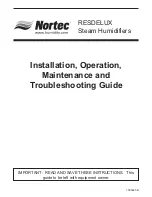
8
EN
GL
IS
H
Note:
• Humidity is low during the winter/spring. If the dehumidifier does not remove any
water it might be because the humidity level is already low.
• Make sure that the rubber plug in the drain hose hole is securely in place before
turning the dehumidifier on if it is not to be used for continuous dehumidification.
• Remember to empty the water tank before moving the dehumidifier.
• Never use the dehumidifier without the air filter in place.
• If the dehumidifier is switched off unintentionally such as by a power cut it will
automatically switch back on once the power is restored.
Emptying the water tank
Note:
Wait a while before pulling the water tank out once the indicator (14) has come on
and the dehumidifier has switched off so that all the water has a chance to drip down.
1. When the water tank is full the indicator (14) comes on and the dehumidifier
automatically switches off.
2. Carefully remove the water tank, take the lid off and empty out the water.
3. Clean and dry the tank and put the lid back on.
4. Slide the tank back into place. The dehumidifier will automatically start
working again.
Continuous operation
When the dehumidifier is used in an environment with high humidity, the water tank
will need emptying often. In such circumstances, it could be more practical to run
the dehumidifier continuously.
1. Remove the rubber plug covering the drain hose connection (7).
2. Connect a drain hose with an inside diameter of 10 mm (sold separately).
Make sure that the drain hose is secure and tight to prevent leakage.
3. The other end of the drain hose should be inserted into a drain which is lower than
the drain hose connection on the dehumidifier.
4. Position the hose in such a way that the water can drain freely. Avoid kinking and
pinching the hose.
5. To discontinue continuous operation, switch the dehumidifier off, unplug it and
disconnect the drain hose.
6. Re-insert the rubber plug into the drain hose connection.
7. Plug the mains lead back in and switch the dehumidifier on again.









































